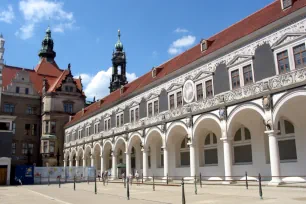The Johanneum is an elegant sixteenth-century building, originally constructed as the royal mews. Today it is home to the Verkehrsmuseum, a museum where you can experience the world of transport.
History
The Johanneum was built in the late sixteenth century as the Stallgebäude, the stables of the Royal Palace. Both horses and coaches were housed here. The Renaissance building was originally designed by Paul Buchner, but has been modified over time.

The double flight staircase was added in 1731 and the upper floor dates back to the mid-nineteenth century, when the structure was converted into a history and armory museum. At the same time, the building was renamed from Stallgebäude to Johanneum, after King John (Johann in German).
But even before this conversion, the building had been used to display works of art, such as a number of sculptures from the royal collection of antiquities. Paintings were exhibited here until the picture gallery opened in the Zwinger.
Transport Museum
Like most of Dresden’s historic center, the Johanneum was in ruins after an aerial bombardment by the Allied Forces in 1945. Since its reconstruction during the 1950s, it has been home to the Verkehrsmuseum (Transport Museum), which displays the history of transportation. It has an interesting collection of old trams, trains, bicycles, planes, cars and model ships.
Langer Gang

The Langer Gang (long corridor), a long arcaded open structure, connects the Johanneum with the Georgenbau, the central building of the Royal Palace. It was constructed in the 16th century as part of the palace’s Stallhof (stables courtyard) to house the horses.
White painted tuscan columns decorated with hunting trophies support the elegant structure, which is decorated with sgraffito and Saxon coats-of-arms. The almost one hundred meter long arcade flanks a courtyard that was used to hold jousting tournaments. Spectators could watch the spectacle from the Langer Gang.
The wall on the other side of the Langer Gang, along the Augustusstrasse, is decorated with a porcelain illustration known as the Fürstenzug or Procession of Princes.
- Next: Yenidze
- More Sights & Attractions in Dresden

